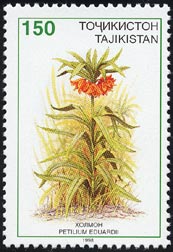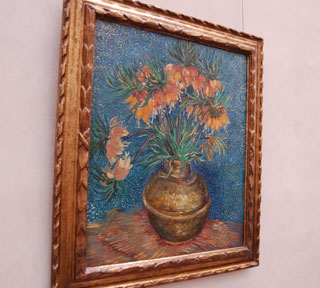Human Flower Project
Friday, December 15, 2006
Top Knots of Tajikistan
In the land where four mountain ranges meet, the giant fritillaria is at home.

Carrying water in Tajikistan
Photo: P. Taylor for European Commission, ECHO
To live at the intersection of mountain ranges takes, what? Exceptional fortitude, for one thing.
We welcome our most recent visitor from Tajikistan, west of China, north of Afghanistan, way up high. We’ve been reading about your country and its stunning scenery, also gazing at some of the gorgeous flowers native to your part of Central Asia.
 Fritillaria eduardii
Fritillaria eduardii
1998 stamp from Tajikistan
Photo: Plant Stamps
One of the most impressive is the giant fritillary. The Missouri Botanical Gardens botanists single out Petilium eduardii [=Fritillaria eduardii]: “the plants sometimes are as tall as 1 m (3 ft) in height with as many as 20 large flowers.” Exceptional all right. The Imperial Crown Fritillaria is also a Tajikistan native, we believe. Its huge, heavy blossoms splayed out from the tops of canelike stems seem less like kings’ crowns to us than clowns’ collars (perhaps an American short-sightedness).
This site provides some information on growing fritillaries, with good precautionary detail: “Plant the bulbs 4 to 5 inches deep and angle them slightly sideways to keep water from collecting in the depression at the top of the bulb.” We also have enjoyed the more and less delicate ways fritillary fragrance has been described: “An unpleasant odor,” says one source. Another: “stinks to high heaven.” And a writer worthy of this plant: “The flowers smell of wet fur and garlic.”
 Fitillaires couronne imperiale dans un vase de cuivre
Fitillaires couronne imperiale dans un vase de cuivre
Vincent van Gogh (1886)
Musee d’Orsay
Photo: Julie Ardery
Our first encounter with Fritillaria imperialis was completely odorless, a painting of them in a copper vase by Vincent van Gogh, in the collection of the Musee d’Orsay, Paris. Not every painter would be up to this subject, just one with no fear of orange (i.e. exceptional fortitude).
Here’s an analysis of the biodiversity in Tajikistan, a blogger vouching for regional hospitality, and a report on foreign aid (with good photographs) by the European Commission.
Wiki says the Pamir Mountains of Tajikistan are called “the knot,” where the Tian Shan, Karakoram, Kunlun, and Hindu Kush ranges converge. Where else but in these valleys would a three-foot fritillary deign to grow?




